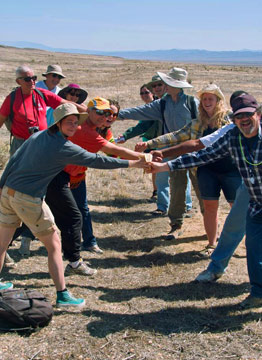Astro 25 - "Field Astronomy in the California Mountains"
The CoVid-19 Virus Has Turned this into an On-Line Course. However, I am leaving most of the narrative and links up here for you, as enrichment for our course.
Apr 9 Presentation , Apr 16 Presentation , Apr 17 Asynchronous Materials to Review
Post-Trip Pictures (well... MY trip to record the Nealley Asteroid Occultation FOR us)
Carrizo Plain is one of the top places in central and southern California to do Astronomy and most certainly a top place to do a combo Astronomy + Planetary Science class such as Astro 25 Spring '20. It's a beautiful wide valley cut by the San Andreas Fault, and the largest remaining tract of native California grassland and native mammal ecology in the state. For this reason, it was designated a national monument for preservation in 1995. It gets few visitors except during the late March / April wildflower season. What with the drought, we'll have few wildflower people this year, I expect. I've done solo retreats, participated in wildflower photo workshops, and brought my Astro 28 students here probably a total of a dozen times over the past 20 years. Check out the post-trip photo pages for my Astro 28 field astronomy classes at Carrizo Plain in 2004, 2006, 2008, and 2012.
Here is a great collection of pictures from our expedition in 2012 to Carrizo Plain for doing a grazing occultation. We're very much hoping to be able to grab the same campsite as you see with the spectacular views in Kirk Bender's photo essay here
This offering of Astro 25 is built around a scientifically valuable astronomical event - the Saturday evening occultation of a decently bright star by the asteroid Neally. Getting precise timings of such events from at least 2 different locations gives 4 points along the sky projected boundary of the asteroid and gives us a precise diameter and first cut at the shape of the asteroid. Cabrillo College has the equipment to set out two stations for this - one at our campsite, and one likely further down on the plain floor. It'll be the focus and motivation for going to an otherwise beautiful place where we can do astronomy, planetary science, and enjoy wildflowers as well. Cabrillo Astronomy is a very active member of the Occultation Astronomy research area, which you can learn more about from the IOTA web site (International Occultation Timing Association). They coordinate and reduce observations of these events from its members and contributes to writing academic journal papers on the results.
Our campsite is high in the Caliente Mountains, with spectacular views overlooking Carrizo Plain, Painted Rock, Soda Lake, and the fault scarps, some of which are visible in the title picture above.

For those who chip in for me to provide you meals, I'll cook my famous (Huell Howser approved!) French Crepes breakfast on Saturday, as well as dinners and a hearty Sunday breakfast. This picture is from a past Carrizo adventure, and from our campsite with the panoramic view.
|
The title picture at top was taken from our camp. The campsite is not at a campground (the two campgrounds are not nearly as interesting as our campsite). There is no water or facilities, so be prepared to "go native", and bring your own water. I'll bring extra water for our meals. The national monument is not primarily for tourists, but instead is designed as a nature preserve for the ecosystems. There is a small, simple Visitor's Center which we'll visit, but the only water in the area is at the campground about a mile from where we'll be bivouacing.

The fault trace created by the Great Quake of 1857 (the Fort Tejon Quake) is still visible and obvious across much of the plain. Here, my 2012 class straddles the fault, knitting together the Pacific Plate and the Salinian Block of the North American Plate
|
During the day on Saturday, we'll explore the landforms created by the evolution of the San Andreas Fault. Carrizo Plain shows the most dramatic and oft-photographed segment of the San Andreas, with scarps, offset stream beds, fault gullys, sag ponds. If we can, we'll try and get a tour of a sacred Chumash Native American site and a rare pictograph panel still showing vivid original colors, at Painted Rock. Next we explore Soda Lake, a huge complex of sag ponds formed from the differing slants of the landscape as the fault moves through the landscape, then to Wallace Creek and other offset stream beds. I'll be giving my famous "micro-lectures" along the way, keeping attention spans sharp by plenty of interspersed hiking and travelling. We might also have time on the way out on Sunday to pause and take a look at the new large scale solar farms (Topaz Solar Farm) going in north of the Monument.
I will have handouts for you describing the planetary processes which govern the inner solar system, Earth, California, and Carrizo Plain and give these out once we're in the camp.
Note that our asteroid occultation, the central science opportunity of the trip, occurs on Saturday night. I hope we can man 3 stations. Me with some students, Kirk Bender with a few more, and then a 3rd station manned by newbie students who'll have to be trained on Friday night. Afterwards, by Sunday morning, things will relax a bit as the time pressure will be less.
Campers Checklist, and another list
Rules of the Field Class
Planetary Processes of the Inner Planets
Late registration
This web page will grow as I prepare for the class, so stay tuned.

